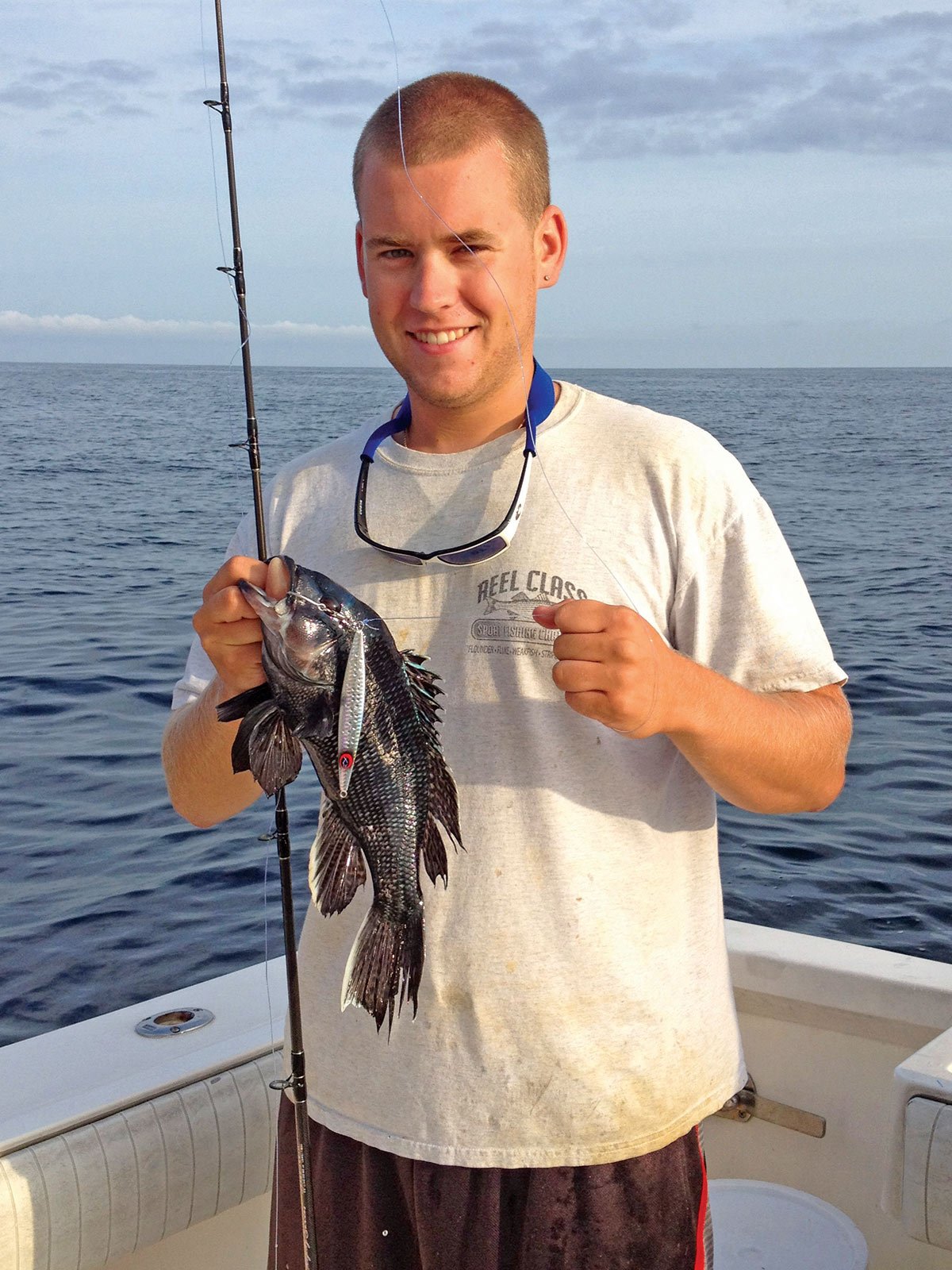In my observations there have been a lot more “small” sea bass around in recent years, fish under 10 inches. Nine times out of 10, when you drop a hi-lo rig to the bottom baited with clam, the little guys will beat the bigger fish to it, and you’ll wind up with a cleaned hook or a throwback sea bass under the minimum size.
Enter the different dimension of diamond jigging for sea bass.
Sea bass, by nature are aggressive feeders, and will readily strike a properly presented diamond jig without any hesitation. Most of the time, when a sea bass hits a diamond jig and you the angler hook it, the fish will most likely be going in the cooler as the larger sea bass tend to hit the jigs and the teasers above them and the smaller fish stay away.

Drift Success
In order to properly present diamond jigs to sea bass, you need to drift over the wreck or reef. Yes, you can do it at anchor, but drifting is by far a more productive approach. In drifting a wreck or rock pile for sea bass, you need a day when you have minimal drift, with less movement with the boat giving you more favorable conditions to do this. There are many days throughout the year when we have no swell, no chop, no wind, and little current, if any, and days like this are perfect for drifting a wreck. The reasoning behind this theory is as follows. You can use your motor to put the boat literally right on top of the part of the wreck you want to fish, and keep it there by simply repositioning the boat if you slide a bit, or to just back the boat right on top of the piece. With this, your window for hitting the honey holes of the wreck is open the widest.
When you introduce wind or current, you are in turn creating movement with the boat, which will push you off the wreck. Being fixed in a stationary position above the wreck is optimal. However, when the movement becomes too much, the drift starts to pick up and that window of opportunity to properly fish the wreck quickly starts closing since you are always on the move. If a slight breeze picks up, or the tide starts moving, you can still fish the piece. However, you have to consider the “sticky” sides of the piece, as well as the speed of your drift. A drift anchor comes in handy in these situations, only unless the drift speed picks up significantly. Once wind and current start pushing you along at a rate of over 1 knot, things will change significantly. If you start having trouble holding bottom, and your window for fishing the piece is only a few seconds, it’s time to put the anchor down.
Gearing Up
A sturdy 7- or 7-1/2- foot conventional rod with a comparable conventional reel, rated MH should do the trick. Spinning gear can also get the job done, and I personally prefer it, but just make sure you have a spinning outfit that can pry a bigger sea bass away from the piece. Spooling with braid is a plus, especially when drifting a wreck. Keep a dowel handy, because if you get hung up in a super-sticky piece of bottom, one place you don’t want to have your hands is wrapped around that braided line. Simply wrap the line around the dowel, and either pull it free or break off. A monofilament shock leader married to the braid via a modified Albright knot or uni-to-uni knot will allow you to tie/retie in an efficient manner.
A 6- to 8-foot length of 40-pound clear mono is a good choice, as it can withstand the rubbing of hard bottom well. Choosing the proper diamond jig is also a big part of the game. AVA27s, 47s, 67s, work well with or without a tail, and a soft bait or fly teaser is always a great option when rigged above the jig itself. If our aforementioned sand eels have inhabited a hard-bottom area as they tend to in the spring, sea bass should be feeding on them heavily. A diamond jig with a black, dark red, or green tail is deadly if sand eels are present and the sea bass are feeding on them.
You can also catch sea bass on Hopkins jigs with white or red bucktail adorned hooks, 2- to 3-ounce Crippled Herrings, or Kastmasters with green or red tails. Again, teasers rigged above the jig, roughly 12 inches up via a dropper loop get a lot of strikes. Pink Fin-S Fish in 4-inch sizes, any Gulp imitation for sand eels, or any Gulp twister/grub-like imitation will do just fine when threaded onto a 3/0 baitholder hook. Drifting and diamond jigging the inshore snags for sea bass in the spring and early summer can be very productive. On slow days with the fluke and stripers, you can always hit a local snag and save the day.




